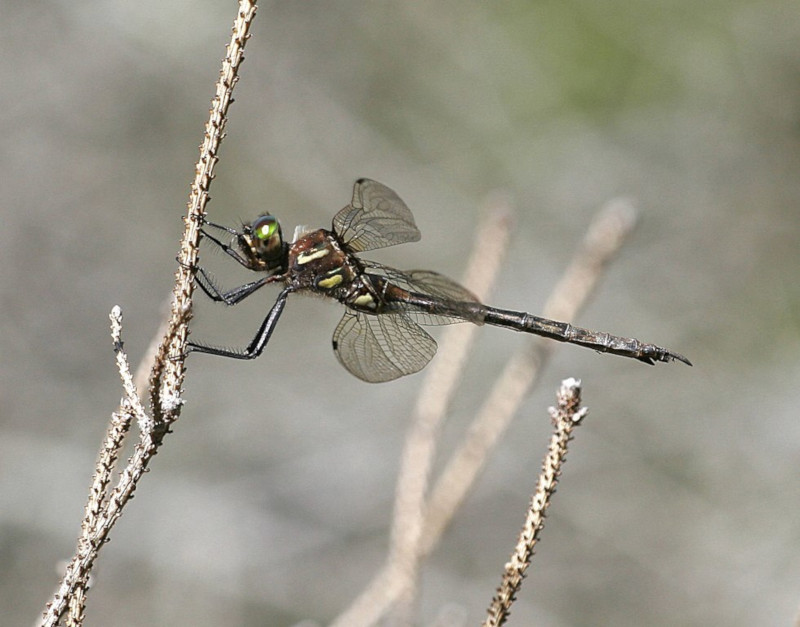Hines Emerald Dragonfly Facts
- The highly descriptive term of the Hines Emerald Dragonfly serves as the common name for a particularly lovely variety of arthropod. Though somewhat lengthy, this nevertheless remains easier to pronounce than its scientific name.
- This statement holds true since that term remains that of the relatively tongue-twisting Somatochlora hineana. Which name one uses to speak of it has no bearing on one’s ability to appreciate the beauty and grace of this insect species, though.
- Somewhat uniquely, opinions about its status vary between organizations. As a result, the country in which the majority of its population exists lists it as Endangered. Yet, the IUCN currently lists the arthropod as Least Concern.
- Quite unfortunately, the beautiful Hine’s Emerald Dragonfly faces several threats to its continued survival. Regardless of its official status, the invertebrate faces great danger from both habitat loss and the ongoing effects of climate change.
- In a pleasant change of pace, active efforts to maintain the species remain underway. These include protecting areas of its specific habitat and attempts to encourage expansion of its range. Efforts to clean such habitats of pollutants remain ongoing.
Related Articles
Hines Emerald Dragonfly Physical Description
The Hines Emerald Dragonfly distinguishes itself from its peers in two ways. This magnificent work of Nature distinguishes itself from similar creatures due to a matter of size. That’s due to the fact that it evolved as an above-average sized variety of dragonfly.
Yet, this truly remarkable arthropod also developed the physiological trait of sexual dimorphism. In its case, this characteristic manifests itself in terms of differences in body length. More precisely, the females attain a slightly greater length than the males.
Overall, however, the difference remains comparatively minor. With the genders taken together, adults reach a typical body length measuring roughly 2.5 in (6.35 cm). Wingspans for this visually impressive insect species further average about 3.3 in (8.4 cm).
Yet, its size alone isn’t all that makes the Hines Emerald Dragonfly amazing. The name itself derives from the distinctive bright emerald green color of eyes. The body also presents a metallic green. Plus, most specimens display one or more yellow stripes on the sides.
- Kingdom: Animalia
- Phylum: Arthropoda
- Class: Insecta
- Order: Odonata
- Family: Corduliidae
- Genus: Somatochlora
- Species: S. hineana
Hines Emerald Dragonfly Distribution, Habitat, and Ecology
The breathtaking Hines Emerald Dragonfly only inhabits a relatively small section of the globe. That’s due to the fact that it only appears on select portions of the continent of North America. More precisely, most of its range appears in the continental United States.
There, individual populations presently only appear in a total of 4 states. Those consist of Wisconsin, Illinois, Michigan, and Missouri. Nevertheless, a significantly smaller population also exists in Canada. There, the insect makes its home in the province of Ontario.
Within this already limited range, it remains extremely selective of its choice of habitat, however. It appears almost exclusively in regions of wetlands, wet meadows, forests, and marshes. Even there, though, it generally lives around slow moving streams.
The species actually spends the majority of its life as a nymph. In point of fact, it spends between 2-4 years in that state, living in the water. When it finally emerges from the water as adults, it is only to breed. After leaving the water, it only lives for 4-5 weeks.
Both the larval and adult stages of the gorgeous Hines Emerald Dragonfly evolved as carnivorous in nature. The adults most commonly feed on a variety of small flying insects. Species such as gnats and mosquitoes comprise the great majority of its diet.
In turn, it itself falls prey to a wide variety of predators. This holds true for both the adults and the nymphs. Turtles, amphibians, and crayfish frequently prey on the nymphs. The adults, meanwhile, often fall victim to birds, frogs, spiders, and even other dragonflies.
Species Sharing Its Range
Check out our other other articles on 4 Beguiling Bats, Pesquet’s Parrot, Havasu Falls, Sangai, Lady’s Slipper Orchid, Velvet Belly lanternshark, Mary River Turtle, Purple Frog, Evening Cicada

